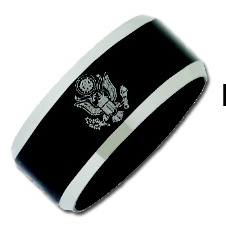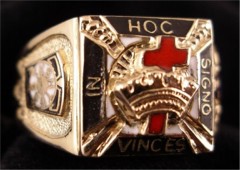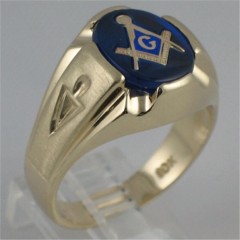 Blue Lodges, Craft Lodges or Ancient Craft Lodges refer to the lodges that work the first three Masonic degrees. The Blue Lodge is said to refer to the traditional colour of regalia in Lodges derived from English or Irish Freemasonry. Admission to membership in the Lodge, as in any body of Masonry, is by petition.
Blue Lodges, Craft Lodges or Ancient Craft Lodges refer to the lodges that work the first three Masonic degrees. The Blue Lodge is said to refer to the traditional colour of regalia in Lodges derived from English or Irish Freemasonry. Admission to membership in the Lodge, as in any body of Masonry, is by petition.
Freemasons do not recruit members. A man who wishes to join the Lodge must request a petition from a Brother. Once you become a Master Mason you are entitled to wear the Masonic Blue Lodge ring.
Fox Jewelry has just added its collection of stainless steel Army and Marine rings. These rings would make a great Christmas present for our military men returning this holiday season. Made of high quality stainless steel, these rings will be a keepsake forever!
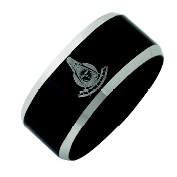 Gold prices have soared in the last few years. High prices have placed a quality gold masonic ring out of the reach of many of our Masonic brothers. Fox Jewelry has dones its best to offer alternative metals to make our Masonic rings more affordable. These new stainless steel Masonic rings are beautiful and will last a lifetime!.
Gold prices have soared in the last few years. High prices have placed a quality gold masonic ring out of the reach of many of our Masonic brothers. Fox Jewelry has dones its best to offer alternative metals to make our Masonic rings more affordable. These new stainless steel Masonic rings are beautiful and will last a lifetime!.
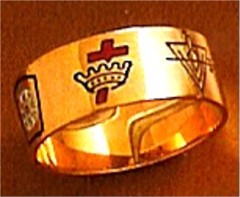 The Knights Templar were officially endorsed by the Roman Catholic Church around 1129, the Order became a favored charity throughout Christendom, and grew rapidly in membership and power. Dressed in their distinctive white mantles with a red cross, the Knights Templar were among the most skilled fighting units of the crusades] Non-combatant members of the Order managed a large economic infrastructure throughout Christendom innovating financial techniques that were an early form of banking. The finest Knights Templar rings available can be found at Fox Jewelry. An example of a Knights Templar ring can be found in the online store.
The Knights Templar were officially endorsed by the Roman Catholic Church around 1129, the Order became a favored charity throughout Christendom, and grew rapidly in membership and power. Dressed in their distinctive white mantles with a red cross, the Knights Templar were among the most skilled fighting units of the crusades] Non-combatant members of the Order managed a large economic infrastructure throughout Christendom innovating financial techniques that were an early form of banking. The finest Knights Templar rings available can be found at Fox Jewelry. An example of a Knights Templar ring can be found in the online store.
The Knights Templars’ existence was tied closely to the Crusades. When the Holy Land was lost,
support for the Order faded. Rumors about the Templars’ secret initiation
ceremony created mistrust, and King Phillip IV of France who was deeply in debt
to the Order, took advantage of the situation. In 1307, many of the Order’s
members in France were arrested, tortured into giving erroneous confessions,
and then were burned at the stake. Under
pressure from King Philip, Pope Clement V broke up the Order in 1312. Portugal was the only European country where the Knight
Templars were not persecuted and arrested. An example of the ring worn by the Knights Templar is shown in the category Knights Templar Rings.
 Recently several Grand Lodges have reintroduced an old tradition, that of accepting a Lewis into the Craft. A Lewis is the son of a Mason who may be admitted in to the Craft upon his 18th birthday. Once he is maded a Master Mason the individual is entitled to wear the Master Mason Ring.
Recently several Grand Lodges have reintroduced an old tradition, that of accepting a Lewis into the Craft. A Lewis is the son of a Mason who may be admitted in to the Craft upon his 18th birthday. Once he is maded a Master Mason the individual is entitled to wear the Master Mason Ring.
 There is ample evidence that the Past Master Degree was worked in America in the last half of the 18th Century. The first reference to what was probably the Past Master Degree is the working of the Excellent Degree in St. Andrew’s Royal Arch Lodge on August of 1769 in Boston. It is an honor to wear the Past Master Ring.
There is ample evidence that the Past Master Degree was worked in America in the last half of the 18th Century. The first reference to what was probably the Past Master Degree is the working of the Excellent Degree in St. Andrew’s Royal Arch Lodge on August of 1769 in Boston. It is an honor to wear the Past Master Ring.
 The Past Master Degree in Masonry is an honorary degree. It is more closely associated with sumbolic than capitular Masonry. It is primarily a necessary or rational degree, containing little of the deep sumbolism of the Mark Master and Royal Arch Degrees. The recipients of this degree are caled Virtual Past Masters, while those who receive the degree prior to their installation as Worshipful Master are called Actual Past Masters. Once becoming a Past Master, the recipient is entitled to wear a Past Master Ring.
The Past Master Degree in Masonry is an honorary degree. It is more closely associated with sumbolic than capitular Masonry. It is primarily a necessary or rational degree, containing little of the deep sumbolism of the Mark Master and Royal Arch Degrees. The recipients of this degree are caled Virtual Past Masters, while those who receive the degree prior to their installation as Worshipful Master are called Actual Past Masters. Once becoming a Past Master, the recipient is entitled to wear a Past Master Ring.
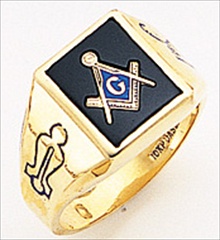 While there probably are some actual stone-workers who are Masons, Masonry does not teach it’s membership the literal techniques of stonework. Rather, it
While there probably are some actual stone-workers who are Masons, Masonry does not teach it’s membership the literal techniques of stonework. Rather, it
takes the actual ‘operative’ work of Medieval Masons and uses it as an allegory
for moral development. Thus, the symbols of Masonry are the common tools that
were used by medieval stonemasons: the gavel, the rule, the compass, the square,
the level, etc. Each of these has a symbolic meaning in Masonry. For example,
Masons are said to meet ‘on the level’, meaning that all Masons are brothers,
regardless of social status, personal wealth, or office within the Lodge or in
the world at large. Similar symbolism exists for other tools.
